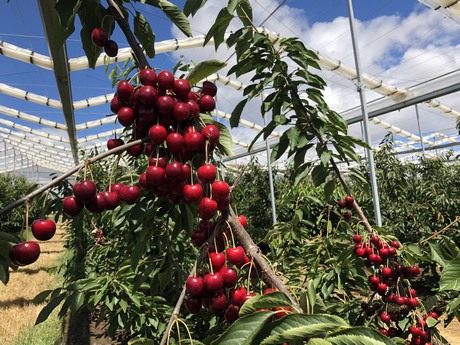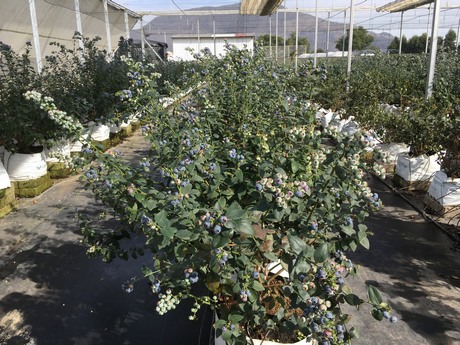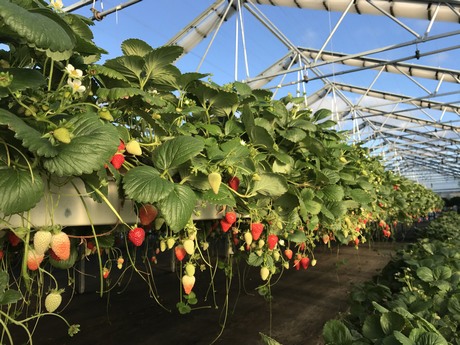“Although we’ve been in business for 42 years, we doubled the size of the company in 2018,” says Richard Vollebregt, President of Cravo Equipment. This dramatic growth is driven by a combination of geographic as well as crop expansion. When the company started building retractable roofs back in 1981, the focus was on the floriculture and reforestation industry in North America. Growers were looking to grow their plants in a natural environment but wanted an opportunity to protect them from rain or cold. Then in 2007, Cravo widened their focus to vegetable crops such as tomatoes, peppers, cucumbers and lettuce in Mexico, where high heat and high radiation limit how long one can profitably harvest in conventional greenhouses.

Photo taken at Reid Fruits in Tasmania, Australia
Crop expansion
Around six years ago, a Research & Development project with Michigan State University resulted in a significant change in Cravo’s marketplace. “With the university, we started developing production protocols using retractable roofs to improve yields and change the harvest timing for the cherry industry,” Vollebregt said. “We didn’t know these trials would have such a huge impact on the development of our business. Today, we have retractable roofs over cherries in four different continents around the globe, including North America (US), Africa (South Africa), Europe (Hungary) and Oceania (Australia and New Zealand). Based on the number of inquiries we are getting it appears that Chile will be next.”
Five years ago, Cravo also expanded into the berry segment with the “Sustainable Strawberry Project” in the UK with Total World Fresh and Marks & Spencer, followed by blueberries in Mexico. In both cases, the goal was to develop production protocols that increase the number of fruit, fruit size and firmness while at the same time reduce fungicide and insecticide usage. The most important goal was to shift the harvest timing to be earlier or later than what normally occurs in conventional tunnels.

Blueberries at a commercial grower in Mexico
Investment in trialing facilities
To further support the growth in the berry industry, Cravo then invested in two retractable roof facilities in Mexico where they are trialing strawberries, raspberries, blackberries and blueberries. One facility is located in Culiacan at sea level where temperatures are very high and tunnels would not work well due to the excessive heat. The other facility is in Irapuato which is at 1,700m elevation where high radiation, low humidity and extreme summer rains are the challenge. These initial projects led to investments by berry growers in Canada, Lithuania, Mexico, India, Australia and New Zealand, all wanting to improve mother plant production, propagation of cuttings and commercial fruit production.

Strawberries at My Country Magic in Nova Scotia Canada.
Geographic expansion
Cravo is headquartered in Canada and until 10 years ago, the majority of its sales were generated in Canada, the US and Mexico. “However, our specialization in automatic retractable greenhouses, cooling houses and orchard covers has resulted in expansion around the globe,” shared Vollebregt. “We are not looking to recreate nature in a closed greenhouse in a cold climate. We believe that growers in mild and hot climates can achieve better financial results by combining the benefits of the natural outdoors with the benefits of climate optimization and automatically protecting crops from loss due to extreme weather conditions.”
“As a result of our willingness to invest in researching crop performance in retractable roof houses and sharing what we learned with growers on the new crop management strategies, some of our fastest growing markets are countries like India and Australia where they are challenged with growing crops during the extreme summer heat.” Today, the company is active on all six continents. “In order to provide our customers the support they are looking for, we have built a global sales and technical support team,” added Vollebregt.
Cherries and berries now larger than vegetables
All in all, the international expansion in combination with the expansion into new crops has resulted in significant changes to Cravo’s marketplace. Where Cravo’s business used to be driven by vegetable crops, over the last six months, cherries and berries were stronger than vegetables. According to Vollebregt, there is a simple explanation why berries and cherries are growing so much faster. He explains there are about six or seven different styles of greenhouses that can be used to grow tomatoes. To grow blueberries, strawberries or cherries on the other hand, there are not as many options for protection since these fruits grow larger, sweeter and firmer when outside conditions are ideal. At the same time, they need protection from rain, wind, frost, hail and extreme heat. “Most growers really only have the choice of producing outside, in a conventional tunnel, a rain shelter or with an automated retractable roof.” he explained. “One of the biggest areas of focus for berry and cherry producers is to expand their production away from the low-price windows which requires them to be able manipulate the growing environment in ways that they cannot achieve with a stationary roof.”

Blackberries and raspberries at the Cravo Demonstration house in Culiacan Mexico.
What’s next for Cravo? “We are now getting many inquiries from the cannabis market, which combined with our existing markets, is keeping our hands full right now,” said Vollebregt. “We are not looking to research any additional crops at the moment, but when customers approach us with a climate problem that they want to solve, we always try to find a way to help them. For now, we will focus on helping our customers getting even better results on each of the existing crops in the different geographic climates before we undertake any new initiatives,” he finished.
Next week, Cravo will be exhibiting at Fruit Logistica in Berlin. If you would like to meet with one of the company’s representatives, stop by booth A-17 in Hall 6.1
For more information:
Richard Vollebregt
President
Cravo Equipment Ltd
Phone: +(1) 519 759 8226 x 215
richardv@cravo.com
www.cravo.com
